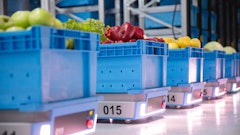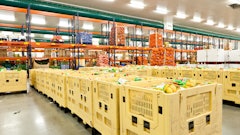
Over the past few years, supply chain disruptions, product shortages, and inflation have shifted consumer purchasing preferences and shopping channels in many ways and it's possible that consumer shopping behaviors will continue to challenge grocers’ supply chains in 2024.
As consumers continue to keep an eye on the economy and inflation's impact on their household budgets, shifts in consumer behavior are creating volatility and complexity in grocery supply chains. Consumers are now showing a strong preference for value-focused brands such as generic and private label, and households that are below $100,000 annual income have been trading down across fresh produce, dairy and meat, and shelf staples according to McKinsey’s State of Grocery 2023. The report shows that consumers have also maintained an interest in purchasing groceries through e-commerce channels, which requires support for various store formats and omnichannel options.
Here are 4 factors grocers should focus on in 2024 to maintain a successful digital transformation amid shifting consumer preferences and an evolving industry landscape.
Maintaining operational efficiency amidst changing consumer product and channel preferences
Significant shifts in consumers’ choice of shopping channels with the move to omnichannel require gaining insights into how these shifts impact the end-to-end supply chain. Grocers are re-evaluating their supply chain networks with changes in flows, policies, and parameters to balance the needs of both brick-and-mortar and online customers. To balance these needs, many are putting operational systems into place to support the growth of online grocery shopping, with ship-to-consumer (from store, dark store, distribution center) or click-and-collect, as well as last-mile delivery strategies.
To gain operational efficiency, grocers need to rationalize their assortments across different store formats and make changes to their supply chain network design and policy parameters to deliver profitable growth. This begins with identifying the consumer and market forces that influence demand and bringing in pricing and promotion plans to create an accurate forecast at a granular level. Optimal allocation can improve inventory imbalances due to a reduction in working capital and spoilage. There is also an increased focus on root cause analysis for out-of-stocks, shrink, spoilage, and unwanted markdowns to continuously improve fulfillment efficiency.
Demand forecasting
To respond to changing consumer buying patterns quickly, many grocers are employing forecasting techniques that leverage demand sensing capabilities. Demand sensing eliminates supply chain lags by continuously learning and reducing the time between demand signals (order frequency, order size, local events, consumer mobility, DC/store inventory, point-of-sale) and the response to those signals.
The latest machine learning (ML) techniques that incorporate grocers’ internal drivers and external casuals improve the accuracy of forecasts across all channels. An accurate and responsive sell-thru forecast enables the complex orchestration of the end-to-end retail supply chain so that the right item arrives at the right location at the right time in the right quantity with the lowest possible investment in working capital. In 2024, more grocers will likely incorporate demand sensing from retail media ads. Grocers are earning a revenue stream from brands advertising on grocers’ websites and customer interaction with ads can be a good indicator of consumer demand.
Demand shaping
Grocery retailers shape demand through promotions and campaigns across stores and online channels. The shaping of demand will have an emphasis towards promoting their own private labels to track changing consumer preferences as they trade down. There are also omnichannel demand shaping activities such as placement on the website, special offers like free shipping, price reductions, email offers, digital coupons, and social media campaigns, which drive incremental sales.
Robust modeling of these demand shaping activities also benefits from ML techniques, and allow category managers to run “what-if” scenarios by looking at the impact of changing the timing and duration of promotions, trying different product placement strategies on the feature insert or the website, and understanding the impacts of different levels of price discounts or free shipping.
Optimizing product availability
Even when applying robust granular level forecasting, grocers still encounter out-of-stocks and inventory in the wrong locations, leading to expedites and unnecessary transfer costs. This is where including Generative AI use cases can add value; GenAI will be harnessed to create knowledge assistants that can anticipate issues in advance, and make prescriptive recommendations to take actions that will minimize out of stocks and allocate inventory to stores based on localized demand patterns.
These algorithms need to act on a digital representation of the end-to-end supply chain to enable planners to fully explore options, assess risks, and evaluate trade-offs to automate decisions. This requires a digital twin, which is a digital representation of the physical supply chain, where every asset is represented with its capacities and connections and available to be analyzed in real-time to determine the next best action when exception conditions are detected. With the application of artificial intelligence/ML techniques on top of the underlying digital twin, retailers can evaluate trade-offs between demand, sourcing, transportation, network alternatives, inventory, and service in a holistic fashion.
Maintaining service and margins in this volatile and uncertain environment requires a digital transformation of grocery retail with a relentless focus on anticipating consumer demand, shaping consumer purchases with pricing and promotions, localized assortments, and fulfilling demand across all channels in the most cost-effective manner.

























